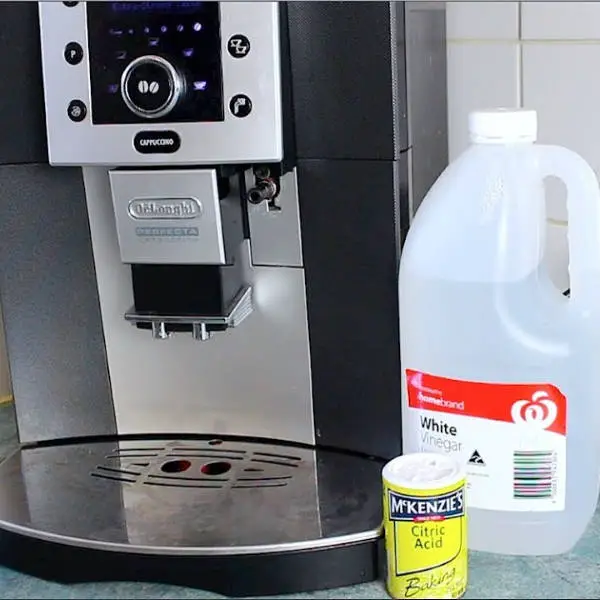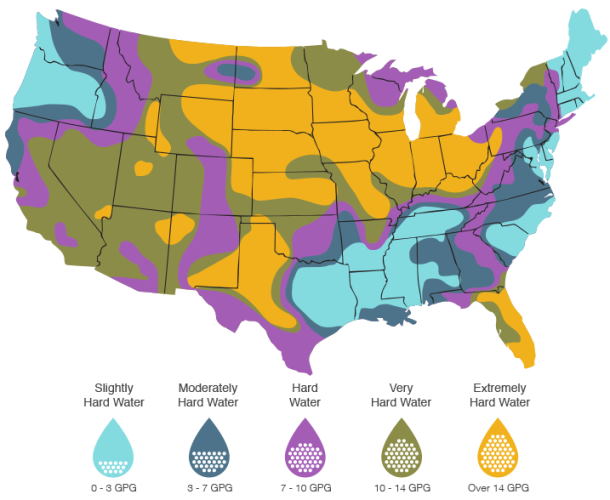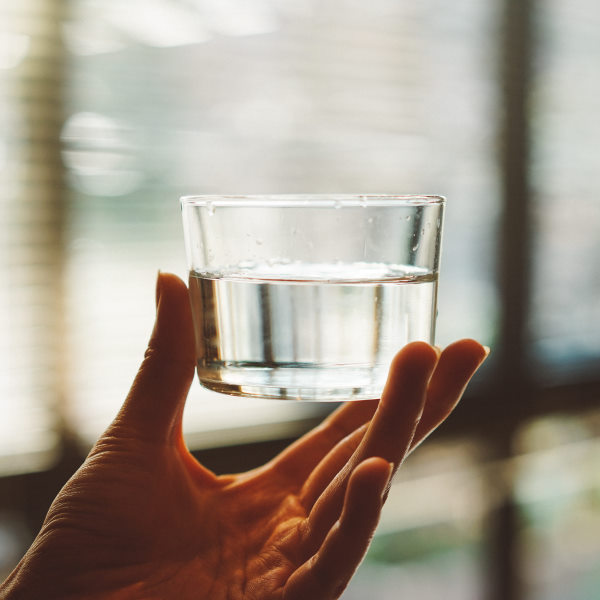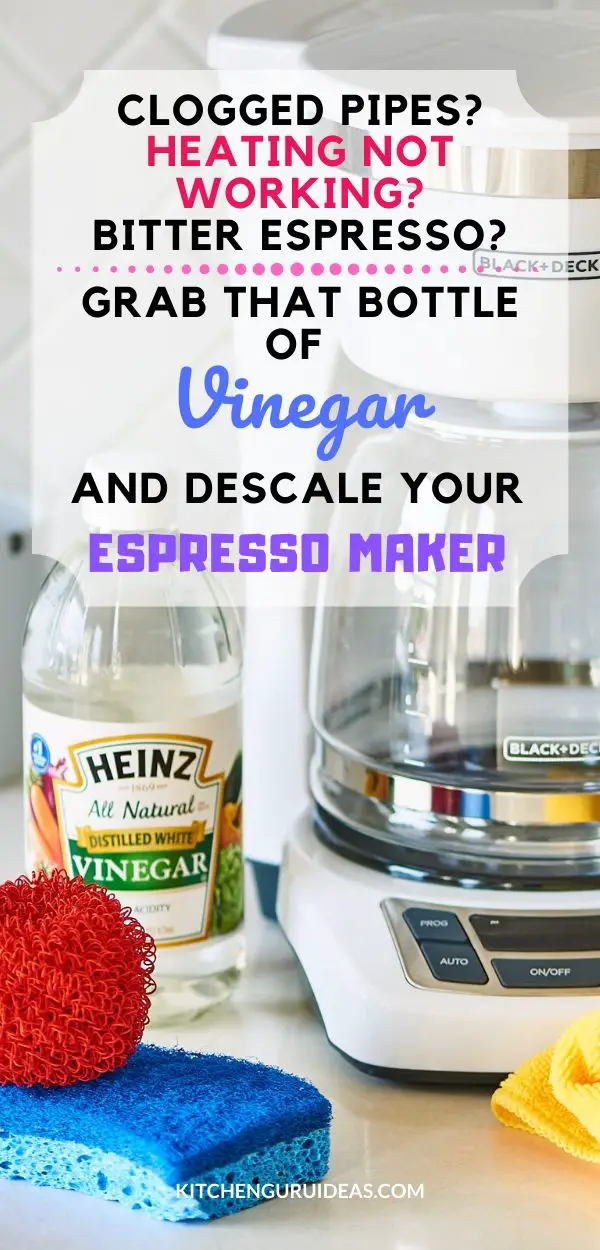
If the health and longevity of your espresso machine are important to you, then keeping it clean is a must.
One way of keeping the machine clean is called descaling or decalcifying.
Over time, limescale can build up inside your machine, which can result in clogs or permanent damage.
Additionally, when the innards of your espresso machine are lined with the stuff, this means you are drinking traces of it.
Now, as long as the quantities remain low, you won’t experience any adverse side effects.
However, mineral buildup affects the taste of your beloved espresso, which is another thing to consider.
Imagine, your whole day ruined just because your morning cup tastes like chalk.
This kind of limescale buildup can happen to anyone, but the people at the highest risk of experiencing this are the ones with hard water. Most U.S. homes have it, but it doesn’t have to be a cause for concern.

By following my 6 easy steps, you can keep your espresso machine devoid of any limescale traces, keeping your machine shooting out streams of utter perfection each and every time.
Alternatively, you can take a look at this video if you don’t like reading long texts.
Step 1 – Which Kind Of Vinegar?

Finally deciding to restore your prized espresso brewer, you open the cabinet door only to see many vinegar bottles: white, apple cider, balsamic, wine, …
So, which one to choose?
In general, it doesn’t really matter that much because all of them contain acids required for descaling.
All is down to personal preference – most importantly, which one has the best smell.
I descale my machine once a month and my personal choice is apple cider just because I like apples.
I suggest trying each one before choosing your favorite.
Step 2 – Make The Solution
Once you decide what you will be using, mix it with water.
A solid, general mix involves 1 part vinegar to 2 parts water.
The ratio also depends on when was the last time you descaled your machine. Obviously, the longer the machine hasn’t been cleaned, the more vinegar you should add.
That’s why some guides suggest a mixture as high as 50/50.
Once you combine the 2 ingredients, give it a quick stir.
Step 3 – Run It Through

This is the fun part.
Once you have your solution all ready, pour it into the reservoir of your machine, and go through the steps as if you were making espresso.
This heats the solution and runs it through the system, dissolving all that residual limescale that’s been building up inside your machine.
If you have a steam wand, run the solution through it as well.
No part of your machine is safe from the threat of limescale.
Pro Tip: Stop the brewing process halfway and let the mixture sit for about 20-30 minutes to completely dissolve the mineral deposits.
Step 4 – Rinse It, Then Rinse It Again
Once you’re done brewing, fill up the reservoir with plain water (you can use distilled water if you want to be sure it stays ultra-clean) and run it through the machine several times.
Keep in mind, you want all traces of vinegar out of your machine, and running plain water through will make sure that your machine is fully prepped to make a steaming shot of espresso just as soon as you’re all finished.
Step 5 – Make Sure It’s All Clean
When you’re done rinsing, look at the water that comes out of the machine.

Is it cloudy? Does it smell like vinegar?
If it smells and looks like water, then it is water.
Your machine has been fully descaled, rinsed, and ready to go.
Step 6 – Reward Yourself For A Job Well Done
There’s only one way to make sure that your machine has been fully descaled.
You’ll have to make yourself a nice shot of espresso.
I suppose this is an optional step, but there’s really no reason not to.
How Much Is Vinegar Effective As A Descaler?
Vinegar contains acids that are strong enough to dissolve limescale.
Also, nothing will go wrong if traces are left in the machine while descaling and we ingest it while drinking our morning cup (as opposed to some commercial descalers on the market).
Another great thing about vinegar is that it’s environmentally friendly.
Some descaling solutions have harsh chemicals in them and must be disposed of properly. With vinegar, once done using it, you can pour it right into the sink without any worries.
However, as great as it is, it’s not without downsides.
If you have neglected your machine for quite some time and a lot of limescale has accumulated over this time, completely removing it with vinegar will be almost impossible.
Also, some people aren’t that fond of their kitchen smelling like vinegar.

To Quickly Summarize
- Elegant and practical
- Made from trusted Swedish material that is durable and performance-oriented
- Lifetime warranty
- Extremely sharp and durable blades
- The set includes only 3 knives
A Fountain Of Youth For Your Espresso Machine
This same descaling process can be used for more than just your espresso machine (for example, washing machines).
If you live by your Keurig, or use a traditional coffee maker, you can perform the same process, which really just ensures that your preferred espresso creator is always clean, which is never a bad thing.
Here it is, 6 steps, as promised, and no more than a 20-minute commitment, which is worth it, considering the life of your espresso machine (not to mention your cup of coffee) is what’s at stake.
📌 Pin Me for Later Reading! 📌
I suggest you save it to Espresso Machine Cleaning Hacks or Descaling Tips or similar board.

Ever descaled a washing machine with vinegar? Tell me in the comments below.





Hi, I cleaned my espresso machine with vinegar and water….well I got the vinegar and water in the machine and ran it once but friends came over and I completely forgot to remove all the vinegar water mix and flush with clear water. Now a slightly greenish color liquid is coming out. Is this machine now ruined?
The acid in vinegar attacked the copper in the pipes. This is the reason why the liquid came out green. Unfortunately, you won’t know if the machine is fine until you try it. Run another cycle with just water to flush out the remaining vinegar. If you don’t see any leaking in or around the machine, you’re fine. If you do, then the vinegar ate away the pipes and you’ll have to replace the espresso maker.